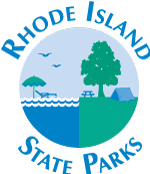Haines Memorial State Park (1911)
Few park developments captured and mirrored the intent and philosophy of the public park movement in Rhode Island more than the gift of 83 acres to the Metropolitan Park Commission by the estate of George B. Haines in 1911. The public park movement begun in the 1880s always had the support of family doctors who saw first hand the public health issues stemming from industrial life of the late 19th century. Over crowding, poor sanitation, deficient diets, and just plain hard work all caused attention among public health workers to focus on the benefits of clean air, clean water, and exposure to sunlight that could be enjoyed in a recreational way at parks and beaches accessible to inner city districts.
Dr. George B. Haines grasped it not only from his personal struggle with asthma, but also from his family practice for decades in the factory precincts of Valley Falls in Cumberland, Rhode Island. Dr. Haines was born in 1843 in Northfield, New Hampshire, and was one of three children. His family was among the founders of that state. During the Civil War, as a young man he worked as an apothecary and surgeon’s assistant at the Portsmouth (N.H.) Navy Yard, and became a graduate of the Dartmouth Medical School in 1871. Four years later he moved to Valley Falls, a major industrial community straddling the Blackstone River between Central Falls and Cumberland, Rhode Island.
In 1876 he married, but was soon, at the age of 34, a widower, his wife died from complications of childbirth. Seven years later, the daughter of that birth was also dead. Nonetheless, Dr. Haines maintained his family medicine profession, primarily serving French Canadian immigrant families for the next decades. In 1909, seeking fresh air for his own asthma problems he bought the Humphrey Farm at Bullock’s Cove on the line between East Providence and Barrington. He spent the year of 1910 there before his death.
The following year, his sister, Ida, who still lived in New Hampshire, sold the farm for a dollar in his memory. It was his intent that the farm be used for “parks, parkway, or boulevard uses only, or purposes in strict harmony therewith.” It had always been the intention by the board of park commissioners to take advantage of opportunities to acquire and set aside shoreline parcels and woodlands along the upper bay and connect them to the metropolitan area by a system of spoke-like scenic boulevards. This was precisely the opportunity that was offered to them by the Haines Memorial gift. That the park could also be accessed by trolley or by the train to Bristol, whose tracks ran along the route of the modern East Bay Bike Path was all the better. Between 1911 and 1915 the Park Commission added more land to the Memorial so that its size ultimately increased to 101.7 acres.
At first, the park consisted of two picnic groves, but later ball fields were added for baseball and other sports of the day. During the Depression of the 1930s, the Civilian Conservation Corps, which was at work in other parks across Rhode Island, built fire places and sculpted turf away from the beach to enhance it for bathers. A boat ramp was installed. A pedestrian footbridge connected Haines with nearby Crescent Park until it was swept away in the ’38 Hurricane. A bath house was added in 1940. More recent developments have made it a stop on the East Bay Bike Path and in 2002 it became the site of a seasonal farmer’s market.
